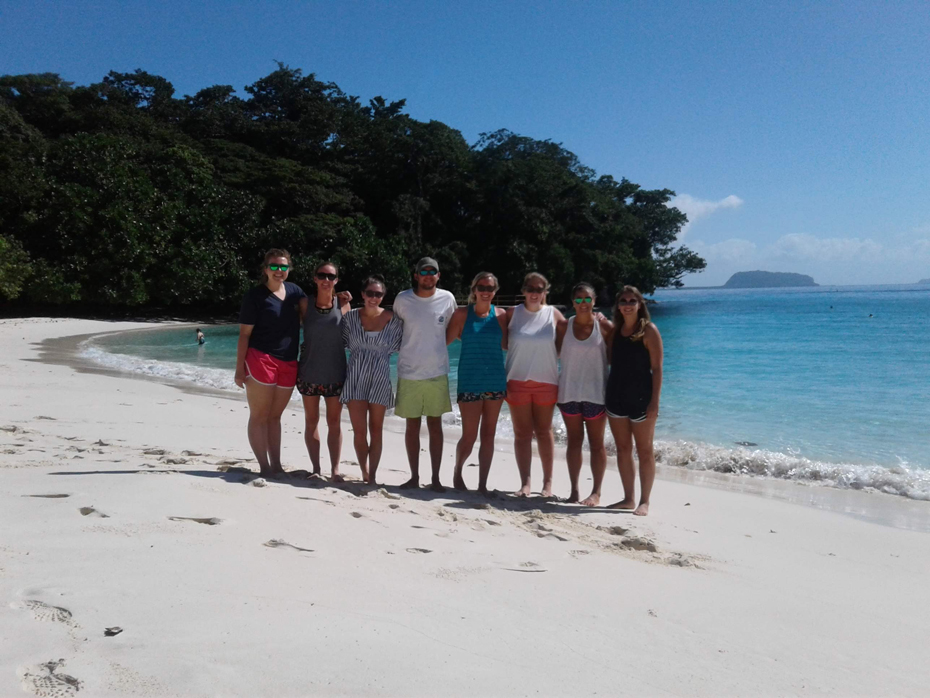Study Abroad Trip to the South Pacific
What is a study abroad trip really like? Last summer Phoebe Jones traveled with history professor Dr. Roy Campbell and seven other PC graduates to the islands of Fiji and Vanuatu. Here’s Phoebe’s take on the two weeks they spent almost 8,000 miles away from the PC campus.

Cargo Cults and Volcanoes
Dr. Roy Campbell looked around at the group of PC alumni gathered before him nervously clutching their bowls of a traditional drink made in Fiji and Vanuatu.
“So you just drink it all down and use the last little bit to swish around your mouth, and then spit it out,” he said. “I don’t usually do that, but that’s how you’re supposed to do it.”
He raised his bowl in a toast.
“To Vanuatu and graduating PC!”
The sound of bowls clinking and people shuddering, as they swallowed the bitter brown liquid reverberated throughout the quiet landscape of Port Vila, the capital of Vanuatu.
Full of Adventure
For two summers, Campbell, a history professor at PC, has led students on a program called New Alumni Adventure: South Pacific. It’s an adventurous trek around some of the most remote places in the world.
During this summer’s trip, alumni students traveled through the Vanuatu islands of Efate, Tanna, and Santo, and around the Mamanuca and Yasawa island chains of Fiji.
It was a combined 30 hours of travel, but it was worth it.
Over the course of 14 days, the group traveled to three of the 83 islands that make up the Republic of Vanuatu.
They saw the most accessible, active volcano in the world in Tanna. The crystal clear water and cashmere sands of Champagne Beach in Santo. The intimacy of the Blue Lagoon of Efate, a natural swimming hole with deep, cold blue water.
The alumni were thrown into the life of a Port Vila tourist, sipping Tusker along the spacious waterfront and watching yachts and cruise ships roll in.
As lush as the trip may sound, it wasn’t all lagoons and oceanfront views.

Learning Local Culture
The trip was an excellent opportunity for the alumni to learn about the impact of the U.S. on Vanuatu and its people.
This could be seen in Santo where the U.S. created a military base during World War II and left behind the wide paved roads, concrete bunkers, and millions of dollars worth of military equipment and supplies, which were dumped into the ocean after the U.S. withdrew.
The group also had the chance to tour a Cargo Cult village and learn about the religion and beliefs of people there.
Cargo Cult villages — like one village the alumni toured — were started with the belief that the U.S. would eventually return to Vanuatu and bring hospitals, infrastructure, and other developments to aid in village prosperity.
Alumni also met members of the independence movement like a ni-Vanuatu native, Sethy Regenvanu. He spearheaded the move away from British and French rule of the country in the late 1970s.

Staying with a Native Family
Sethy and his Australian wife, Dorothy, hosted the alumni group in their son, Nick’s, home.
Sethy amused alumni with tales of growing up on one of Vanuatu’s many islands and the struggles he faced receiving an education and, eventually, becoming the face of the independence movement.
He was even generous enough to sign everyone’s copies of his autobiography, “Laef Blong Mi: From Village to Nation.”
The group also met Nick’s wife, Heidi, who is leading the feminist movement in Vanuatu. She works with villages and local communities to empower women by providing for themselves and their families.
The trip was full of so many adventures from staying with a native family at their B&B in Tanna to shark snorkeling and racing ATV’s around Efate. There really aren’t enough words or photographs to explain it all.
Learn More
Are you thinking about studying abroad when you go to college? Check out our Study Abroad page for nine reasons why you should take advantage of traveling abroad when you go to college.

